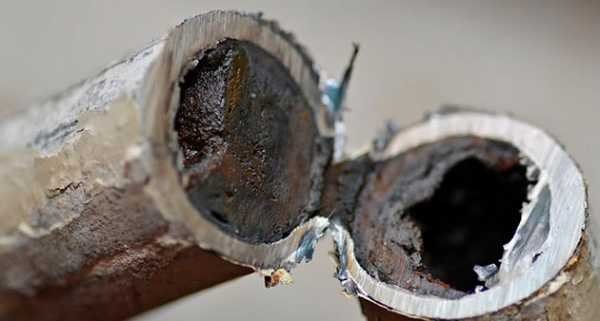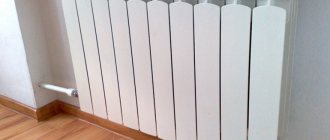How to determine the temperature of heating devices in an apartment. A specialist's answer.
In order to measure the temperature of a heating device, like absolutely any other object, there are devices called pyrometers.
A pyrometer is a device for non-contact measurement of body temperature. The principle of operation is based on measuring the power of the thermal radiation of the measuring object, mainly in the infrared and visible light ranges. The cost of these devices on the Internet varies from 2.5 to 35 thousand rubles. The measurement error does not exceed 1.5%.
To understand how it works, imagine a children's Chinese pointer for 10 rubles. We aimed an infrared beam at an object and measured its temperature. Such devices are available in sufficient quantities in the branches and regional offices of TSK and MOEK - Moscow organizations that generate, transport to the consumer and sell heat.
Only these organizations will not measure the temperature of heating devices. For the simple reason that it is not said anywhere and no one knows what it should be, because calculations of heating systems are made in such a way as to ensure a constant (theoretically) indoor temperature. For the housing stock it is +18 degrees C.
The design temperature of the outside air for Moscow is taken as minus 28 degrees C. This means that if it is minus 40 degrees in Moscow, the heating system will heat your apartment as if it is 12 degrees warmer outside.
There is a so-called temperature schedule - the main law of heating systems. According to this graph, the maximum temperature of the water flowing into the first radiator (heater) of the system, the so-called. "Supply", for the residential sector 95 (because at a higher temperature, sublimation occurs - the ignition of dust in the room), and the highest temperature coming out of the last device, "reverse", is 70 degrees. This is when the outside air is minus 28 and below. You will be able to "catch" the heating system only if you have less than 70 at the calculated temperature of the outside air at the inlet to the device.
Knowledge of room temperature standards help to detect a malfunction and apply for a decision to the appropriate authority.
Temperature indicators are regulated by norms GOST and SNiPa.
What are the temperature standards in the apartment according to GOST in winter and summer

The main indicator is indicated in the document by number 51617-2000. In accordance with it, the temperature should be:
- on a flight of stairs - 14-20 degrees;
- in the lobby and corridors - 16—22;
- in hallways, living rooms and other rooms of the apartment - 18—25;
- in the bathroom - about 24.
More precisely regulates the temperature GOST 30494-2011:
| Season | Premises | Recommended value +/- 1 |
| Cold | Residential | 21 |
| Residential, in the north | 22 | |
| Kitchen | 20 | |
| Restroom | 20 | |
| Bathroom | 25 | |
| Interroom corridor | 19 | |
| Children | 24 | |
| Warm | Any | 23 |
Minimum rates
Heating of premises is important at any time of the year, but especially in winter.


The heating system has typical temperatures that must be respected.
There is a small interval for each room.presented in the table above. As such, there is no minimum threshold.
But there are several indicators, a fall below which indicates a malfunction. This applies to space heating: temperature drops are permitted by law up to 12, 8 and even 4 degrees, but only for a short period of time - 16, 8 and 4 hours respectively.
Maximum indicators of water temperature in radiators
SNiP 41-01-2003 sets temperature limits from above: for piping from one pipe, heating of the coolant is allowed up to 115 degrees, of the two - up to 95 ° C... Despite the permitted values, the values rarely exceed 80-85 ° C.
Minimum temperature standards in apartment rooms
They should be known in cases where a battery with a heating sensor warms up completely, and the coolant indicators are normal, but it is still cold in the apartment. This situation may indicate a low power of the radiator.
There is a minimum for different rooms of the apartment. The temperature should not be lower:
- +16 ° С on the landing, in the lobby;
- +18 ° С in living rooms, in the kitchen;
- +20 ° С in a corner room;
- +25 ° С in the bathroom;
- +4 ° С in the attic, in the basement.
Any of the numbers should be 1.5 m from the floor and 1 m from the outer wall.
Reasons for the lack of heat in the apartment
There are 5 problems, each of which has a solution:
- Deterioration of the piping during operation
A high percentage of apartment buildings were built during the Soviet era. Age pipelines and boilers provide the building with heat, but do not have the proper efficiency.


Photo 1. Blocked pipes in the old heating system. Because of this, the flow of the coolant is disrupted and the radiators do not warm up well.
Outdated equipment is rarely replaced, there is no thermal insulation in the distributors, and side problems arise. The solution is to overhaul the entire building system, but for this you need to contact the supplier with the appropriate act, with the signatures of the tenants.
- Poor hardware setup
In some houses, heating services are serviced by untrained specialists or high-quality personnel, but who do not have engineering schemes. This leads to incorrect regulation of the strapping, respectively, a malfunction. Dealing with this is somewhat more difficult: the management company is unlikely to recruit new employees in connection with a single complaint. Therefore, it is recommended to submit a collective letter with a request to resolve such an issue.
- Errors that occurred during the creation of a project or installation of heating are possible.
You can fix them with a major overhaul with redevelopment and replacement of pipelines.
- Unlawful tampering with the structure or modification of the harness by the user or third parties.
Some residents of apartment buildings independently change the heating system in their apartment, without thinking about the consequences for their neighbors. Violations are:
- increased number of radiator sections;
- expanded heating area;
- connection of additional equipment, for example, heated floors.
- High thermal conductivity of building walls, low radiation protection, other violations of technology during construction.


This mainly applies to old houses, in which insulation is made of low-quality materials or is absent. They also wear out over time, which spoils performance.
This results in a loss of heat going outside. Sometimes a similar problem affects modern buildings: builders may use an unsuitable, less efficient, but cheaper analogue.
As a result, the tenants suffer. The solution to this problem is almost complete overhaul of the heating system, building overhaul.
The annual rise in the price of resources makes the end consumer think not only about their savings, but also about the quality of the provided utilities. One of the most significant expenditure items in paying for an apartment is heating, so consumers monitor its parameters especially carefully. To do this, it is worth finding out what is the temperature of the batteries in the apartment in 2019.


Temperature norms of the heating system in an apartment building
The heating scheme in apartment buildings is built in cooperation with a centralized system to which pipes are connected. Through them, the coolant is sent to the apartment building, where its further supply is regulated by the inlet valves. After that, the water goes through the risers and eventually enters the batteries and radiators of each apartment.
The described processes, as well as everything related to the rules for providing the population with communal resources, is reflected in the Decree of the Government of the Russian Federation of 05/06/2011 No. 354 "On the provision of communal services to owners and users of premises in apartment buildings and residential buildings" (hereinafter - Resolution No. 354). Requirements for the quality of heating are fixed in Section VI of Appendix No. 1 to the rules of Decree No. 354.
In addition, detailed rules for the provision of heating services are spelled out in the Order of Rosstandart dated 06/11/2014 No. 544-st “GOST R 51617-2014. National standard of the Russian Federation. Housing and communal services and management of apartment buildings. Utilities. General requirements "(hereinafter - GOST R 51617-2014) and" GOST 30494-2011. Interstate standard. Residential and public buildings. Indoor microclimate parameters "approved by order of Rosstandart dated 12.07.2012 No. 191-st (hereinafter - GOST 30494-2011).
If the heating does not work
In a warm, non-heating season, you can safely shut off the radiator. This will not in any way affect the comfort of other residents, and the operation of the heating system itself. But remember that after completing the work, you need to open the system. You can forget about it until the heating season, and during the preparation, the utilities will not be able to test the line because of you.
If the heating works.
The main difficulties arise when the heating is working. You cannot just take and shut off the battery if you have one-pipe heating. This will leave the entire riser without heat. To avoid such cases, it is recommended to install a bypass. This is a jumper from the pipe between the inlet and outlet of the radiator. Then the heating will be able to work bypassing your battery and will not affect other residents in any way. But you need to do this at the installation stage. At the same time, it is possible to install control valves in front of the inlet to control the temperature.
If you have two-pipe heating, you can shut off the radiator at any time. And this will not affect the neighbors in any way. To do this, simply turn off the tap.
To understand if a one-pipe or two-pipe system is in use, look at the connection to the radiator. If the entrance goes inside from the pipe, and goes down the riser from the battery, then you have a one-pipe. If the exit leads to another pipe, then you have a two-pipe.


Correct installation with bypass, shut-off valves and temperature controller
Air temperature standards in the apartment
The feeling of comfort from heating a room is subjective. However, there are uniform standards due to the physiological needs of a person, as well as the purpose of the premises in which he stays.
Although there is a fairly wide range of norms prescribing what the temperature of the water in the heating system of an apartment building should be, the standards for the thermal regime of air in an apartment are very unambiguous.
So, in accordance with the standards, the following temperature regime should be maintained in the apartment during the heating season:
- in the living room - 18 ° С;
- in a living corner room - 20 ° С;
- in the bathroom - 25 ° С;
- in the toilet (separated from the bathroom) - 18 ° С;
- in a combined bathroom - 25 ° С;
- in the kitchen - 18 ° C.
This standard in accordance with GOST allows you to preserve the health of residents without exposing them to adverse conditions.
Self-repair of a heating radiator
Finding the leak is usually not difficult. If, nevertheless, it is not possible to determine the problem area, then you can remove the batteries and lower them into a bath of water. In the place where air bubbles appear and there will be a leak.Next, you need to use the methods described above.
A small leak can be eliminated on your own, since special knowledge and skills are not required for this. If you have repaired a heating radiator several times, then it is better to replace such a heating device with a new one.
Battery temperature rate
Factors affecting space heating include thermal conductivity, other technical characteristics, and the procedure for installing batteries. Therefore, compliance with the rules for their installation and use will ensure that the temperature of the heating radiators in the apartment and in the house meets the established standards.
In addition, you should carefully consider determining the number of battery sections depending on the area of the room. For example, a device in which the coolant is heated to an identical temperature will have different effects on the heat flow at 5 and 7 sections on it.
Minimum value
In order to ensure the norms of air heating in residential premises, certain temperature regimes of radiators must be observed. However, at the legislative level, the minimum permissible indicator for the temperature of the battery itself is not established.
It is logical that at a low temperature of heating equipment it is impossible to provide + 18-25 ° С in housing during the cold season.
If the batteries do not provide the proper level of heating, it is worth starting to search for the cause. Before checking what the temperature of the pipes is, you should pay attention to the features of the placement of the device and the availability of free access to the battery.
It is quite possible that the matter lies only in the fact that the radiator is covered with furniture, which prevents the circulation of heated air, or it is fenced off with a special protective panel.


Maximum value
In turn, more attention has been paid to what the upper rate should actually be in winter. So, the permissible maximum temperature norm of a radiator in a dwelling is 95 ° C, if the dwelling is equipped with a two-pipe heating system.
If the system is one-pipe, the maximum battery temperature should not exceed 115 ° C.
It should be noted that the figure is 85-90 ° C as the optimal recommendation. It is defined for practical purposes. This maximum water temperature in the heating system of an apartment building is associated with water boiling at 100 ° C. If this figure is exceeded, the radiator breaks down faster.
Checking the device


It is not enough to choose a suitable measuring device, you also need check after purchase. Experts say what is best before installation check for accuracy of readings.
This is to ensure that the products are the source of accurate data. If a cheap device is selected, then one can suspect that its readings will be inaccurate. Not worth saving on the purchase of products, because a poor-quality device can lead to a distortion of the real picture, a decrease in the efficiency and reliability of the system.
It is quite easy to check, for this you need to take a device and a sensor with a remote spike for water. You need to check the product with open source of fire... It will be enough to bring the thermometer to the fire for 10 seconds, and then do the same with the sensor.
Taking into account the inertia, it is necessary to evaluate the readings that will appear on the devices. It is necessary to compare the readings on the sensor and on the thermometer. The lower the difference, the more accurate the device will be.
How to measure battery temperature correctly
When the issue with the coolant is clarified, you can think about how to measure the temperature of the battery in the apartment. This is easy to do in the following ways:
- Use a regular household thermometer. It needs to be applied to the battery and wait for the moment when it heats up.To take into account the error, it is better to add 1-2 degrees to the obtained data.
- Apply an alcohol thermometer, attaching it to the radiator with tape, and then insulating it with insulating material, such as foam rubber. The information obtained by this method is indicative in dynamics. The device can be left for a long period to constantly monitor the situation.
- Use an infrared thermometer. In practice, they differ in a small error, moreover, they do not require direct contact with the heating device. And the result is delivered instantly.
- Use an electrical measuring device with a thermometer and a sensor. The sensor is installed on the battery, and the device displays its value when the “measure temperature” function is selected.
Repair of a cast-iron heating battery


If a leak appears at the joint, then it can be fixed with epoxy glue, a strip of cloth or a bandage. To do this, soak the bandage with glue and wrap it over the leak. Then, after repairing and drying the glue, you can paint this area to match the battery. Such repairs can extend the life of the radiator by a couple of years.
The second option to eliminate the leak is to apply a clamp. A small piece of rubber can be used to stop the leak. To do this, tighten the rubber in place of the leak.
Another option to fix the leak is to install a metal clamp. It is a metal ring that has sealing plates, they are attached with two bolts.
You can also fix the leak by cold welding. Such welding is a sealing compound that is somewhat similar to plasticine. The principle of operation is as follows: it is necessary to knead the welding to a homogeneous mass, and then glue it to the place of leakage. This welding can be used for small leaks, as it tolerates high temperatures well. If you cannot make repairs yourself, then in this case, you can use the services of a qualified specialist.
How to act if the norms are violated
If it was found that the batteries in the apartment are cold, you should find out whether this is a problem exclusively for this room or all residents of the house have encountered it. A collective appeal always attracts more attention than an individual one.
If the quality of heating is unsatisfactory, which does not comply with SNiP, a complaint can be filed:
- to a service organization: an association of homeowners, a management company, a housing construction cooperative;
- resource supplying company;
- emergency dispatch service;
- housing inspection. It usually has a special hotline for such calls.
Organizations will take the complaint over the phone and then file it. After that, specialists will establish and eliminate the reason for the lack of heating, fixing the violation.
Later, on the basis of the act of inspection of heating networks, recalculation takes place for the period of absence of heat.
If the above organizations do not take any measures to restore heating, you should file a complaint with Rospotrebnadzor and the prosecutor's office.
How to measure the heating temperature in a pipe or boiler: sensors, thermometers and other devices
It is the thermometer that can indicate the problems that have arisen. If the temperature of the liquid has dropped significantly, then you can understand that there is a problem in the system. Such a pointer will allow you to shut down the system until the problem is fixed. This control method is the most convenient, it allows you to set the temperature, change it and at the same time not be near the equipment.
Many boilers operate automatically, the measurement is carried out using special sensors. Sensors and automation harmoniously interact with each other.
Due to this, you do not need to constantly be at the boiler, monitor the indicators, and regulate the temperature.
Heating allows the use of a variety of pipe devices. Many people have to think about which thermometer to measure the temperature with.
findings
The legislator has set standards for the characteristics of the heating system, paying particular attention to the optimal temperature in the living room. Its value is the most important for residents, and it is also easy to check. If it is lower than it should be, then the battery is not hot enough. And in case of non-compliance with the standards, you can file a complaint with the service organizations, not forgetting to recalculate the payment if you discover the fact of providing heating services of inadequate quality.
Lawyer. Member of the St. Petersburg Bar Association. Work experience over 10 years. Graduated from St. Petersburg State University. I specialize in the field of civil, family, housing, land law.













